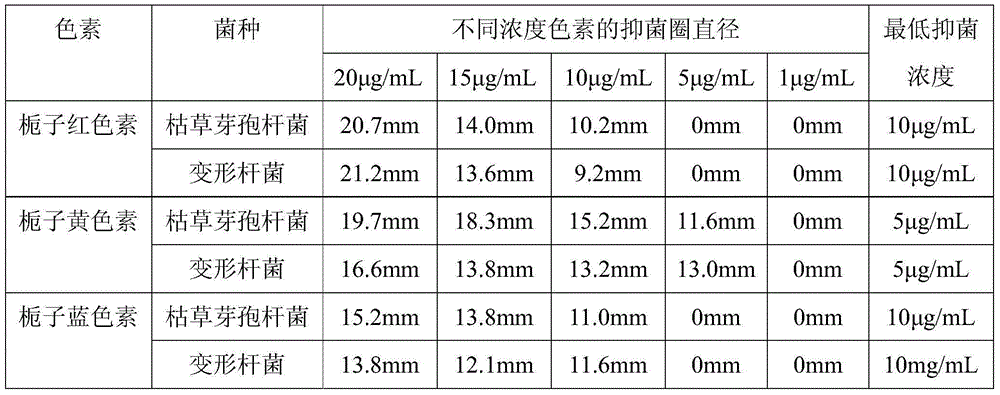Application of gardenia series pigments to bacteriostasis
A technology of gardenia series and gardenia blue pigment, which is applied in the field of food additives, can solve problems such as the limitation of the application range of natural pigments, and achieve the effects of avoiding poisonous problems, good antibacterial function, and soft and harmonious colors
- Summary
- Abstract
- Description
- Claims
- Application Information
AI Technical Summary
Problems solved by technology
Method used
Image
Examples
Embodiment 1
[0015] The preparation of embodiment 1 gardenia series pigment
[0016] (1) Preparation of Gardenia Yellow Pigment
[0017] The gardenia fruit was pulverized through a 40-mesh sieve, and the obtained gardenia powder was extracted with deionized water at a mass ratio of 1:10 at 45° C. for 1 hour to obtain a crude extract of gardenia yellow pigment.
[0018] Refining of gardenia yellow pigment: Adsorb gardenia yellow pigment with AB-8 macroporous adsorption resin, add 30g wet resin to the triangular flask containing 100 mL of crude extract of gardenia yellow pigment, put it into a shaker for adsorption for more than 10 hours , and then filter the resin and solution in the triangular flask together, collect the resin and then pack it into a column. Rinse with 4BV (the bottom area of the separation column is 2.0096 square centimeters multiplied by the height of the resin in the separation column, 14.5 centimeters is 1BV) water, 5BV 20% ethanol, 6.5BV 60% ethanol and collect eac...
Embodiment 2
[0029] The antibacterial experiment of embodiment 2 gardenia series pigments
[0030] Operate under a sterile workbench, cool the prepared beef extract peptone medium to about 60°C and pour it into a sterilized petri dish, and use a sterile pipette to absorb the concentration of 10 6 200 μL of cfu / mL Bacillus subtilis or Proteus bacterial solution was evenly spread on the surface of the plate with a sterile glass triangular coating stick, and it was ready for use. Place 6 sterile Oxford cups on each plate (the inner diameter of the Oxford cup is 6 mm and the outer diameter is 7 mm), one sterile Oxford cup in the middle is the blank control, and the remaining 5 Oxford cups are the sample group. Add 100 μL of sterile water to the blank control, and add 100 μL of an aqueous solution of gardenia red pigment, gardenia yellow pigment or gardenia blue pigment with a concentration of 20 μg / mL filter sterilized to the sample group. Take it out, and then incubate at 37°C for 24 hours, ...
Embodiment 3
[0034] The minimum inhibitory concentration (MIC) experiment of embodiment 3 gardenia series pigments
[0035] Operate under a sterile workbench, cool the prepared sterilized beef extract peptone medium to about 60°C and pour it into a sterilized petri dish, and use a sterile pipette to absorb the concentration of 10 6 200 μL of cfu / mL Bacillus subtilis or Proteus bacterial solution was evenly spread on the surface of the plate with a sterile glass triangular coating stick, and it was ready for use.
[0036] Put 6 sterile Oxford cups on each plate (the inner diameter of the Oxford cup is 6mm, the outer diameter is 7mm), the middle 1 sterile Oxford cup is the blank control, the remaining 5 Oxford cups are the sample group, and the blank control is added with 100 μL sterile Water, 5 Oxford cups numbered 1, 2, 3, 4, and 5 in the sample group were added with 100 μL of filter-sterilized gardenia at concentrations of 20 μg / mL, 15 μg / mL, 10 μg / mL, 5 μg / mL, and 1 μg / mL. The aqueous s...
PUM
 Login to View More
Login to View More Abstract
Description
Claims
Application Information
 Login to View More
Login to View More - R&D
- Intellectual Property
- Life Sciences
- Materials
- Tech Scout
- Unparalleled Data Quality
- Higher Quality Content
- 60% Fewer Hallucinations
Browse by: Latest US Patents, China's latest patents, Technical Efficacy Thesaurus, Application Domain, Technology Topic, Popular Technical Reports.
© 2025 PatSnap. All rights reserved.Legal|Privacy policy|Modern Slavery Act Transparency Statement|Sitemap|About US| Contact US: help@patsnap.com

